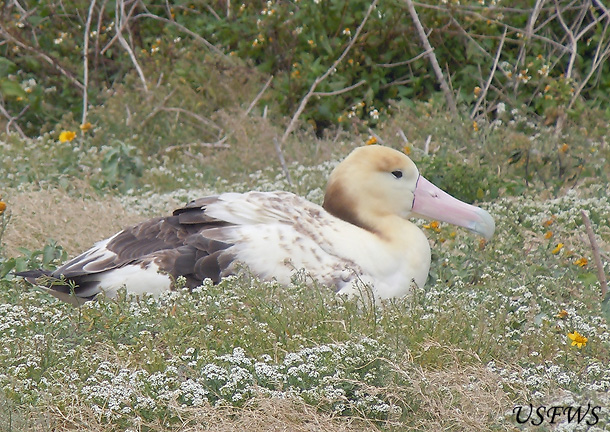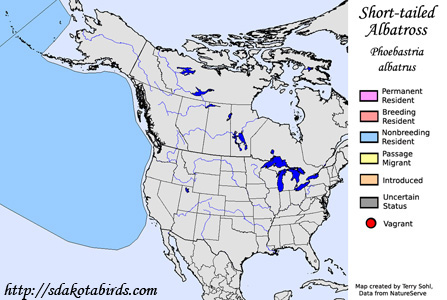| Length: 36 inches | Wingspan: 86 inches | Seasonality: Non-resident in South Dakota |
| ID Keys: Very heavy pink bill. Juveniles brown for multiple years. Adults white back, shoulder, and tail, black wings, yellowish hue on head | ||
 The
Short-tailed Albatross is the largest albatross likely to be found in the
North Pacific. There, they may have been one of the most common
albatross species prior to the 1800s, when feather collectors and hunters
decimated the species. Collection continued into the 1900s, and
populations were also devastated when a volcanic eruption functionally
destroyed one of the largest breeding colonies that remained. By the
1940s, the species was thought to be extinct, as none were returning to
breed on the handful of Japanese Islands where they bred.
The
Short-tailed Albatross is the largest albatross likely to be found in the
North Pacific. There, they may have been one of the most common
albatross species prior to the 1800s, when feather collectors and hunters
decimated the species. Collection continued into the 1900s, and
populations were also devastated when a volcanic eruption functionally
destroyed one of the largest breeding colonies that remained. By the
1940s, the species was thought to be extinct, as none were returning to
breed on the handful of Japanese Islands where they bred.
However, Short-tailed Albatross are extremely long-lived species, with birds living 50 years or more and not breeding until at least 10 years old. During the time when no birds returned to their Japanese breeding grounds, it is thought that a handful of juvenile birds still roamed on the open ocean. By the 1950s, a handful of birds returned to former breeding colonies in Japan and again began to nest. With protection from exploitation, populations have very slowly rebounded since, but they remain a very rare species, with no more than a few thousand birds in the total global population. In recent years, sporadic nesting attempts have started to have been reported from Midway Island on the far reaches of the Hawaiian Island chain, further raising hopes for the species' recovery.
Habitat: Breeding habitat is now reduced to just a pair of Japanese Islands (Torishima and Minami-kojima), and recent nesting attempts on Midway Island in the Hawaiian Island chain. Outside of the breeding season, they are found in open ocean in the Pacific.
Diet: Feeds mostly on squid, but will also feed on fish, shrimp and other crustaceans, and occasionally on the refuse and waste from ships.
Behavior: Foraging is mostly done by swimming on the ocean's surface, grabbing squid and other prey from near the surface when spotted.
Nesting: On the two remaining Japanese nesting grounds, nests occur on grassy windswept slopes, where the female lays a single egg in a simple scrape nest. Both parents take turns incubate the egg, with incubation last 2 months. Upon hatching, parents take turns protecting the young, and leaving to forage, with the youngster fed regurgitated food from the foraging parent. The chick remains in the care of the parents for several months after hatching.
Song: On their breeding grounds, birds will give a groaning call, but they are generally silent off the breeding grounds.
Migration: Breeds on a handful of Japanese Islands, although sporadic breeding attempts have been made in recent years on Midway island on the fringes of the Hawaiian Islands chain. Outside of the breeding season, may wander widely across the Pacific.
Interactive eBird Map: Click here to access an interactive eBird map of Short-tailed Albatross sightings
Similar Species: Adult birds are most likely to be confused with the Laysan Albatross in Pacific waters off North America.
Conservation Status: Overhunting and destruction of their nesting habitats by natural and man-made threats resulted in the near extinction of the species by the mid 1900s. With protection, populations have begun to rebound, but no more than a few thousand birds exist worldwide. Given the small population, the dependence of the species on a handful of breeding locations, and the threats of fishing activity, climate change, and pollution, the IUCN lists the Short-tailed Albatross as "Threatened".
Further Information: 1) U.S. Fish and Wildlife Species Profile - Short-tailed Albatross
2) U.S. Fish and Wildlife Endangered Species - Short-tailed Albatross
3) BirdWeb.org - Short-tailed Albatross
Photo Information: U.S. Fish and Wildlife photo - Taken on March 4th, 2012 on Midway Island - Photo licensed under Creative Commons Attribution 2.0 Generic License
| Click below for a higher-resolution map |
 |
| South Dakota Status: Non-resident in South Dakota |
Additional Short-tailed Albatross Photos (coming soon!!)
